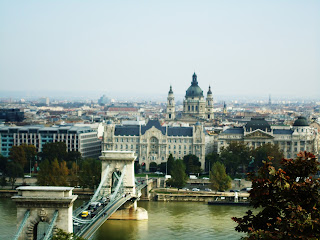Exhausted after a non-stop weekend in Munich, Germany, we left Monday morning to head to Dachau before continuing to the next destination on our 10 day, Prague. Unfortunately, upon arrival in Dachau we learned that on Monday of all days, Dachau is closed. We were disappointed but I enjoyed walking around the parks in Dachau before the long bus trip. We had a smooth trip to Prague and arrived at our hostel around 7 PM. The hostel we stayed in was St. Christopher's Inn @ the Mosaic House and it was more like a high end hotel rather than a hostel- AMAZING! The bathrooms had rain showers and the bar downstairs played live music during the happy hour, it was also full of young people. After getting settled, we walked down the street and found a Thai restaurant for dinner, I had fantastic green vegetable curry. We were all exhausted still from Oktoberfest so we called it an early night.
On Tuesday morning we woke up early for the free Prague walking tour. We made friends with a few Aussies that were also staying at our hostel. On the tour we were able to see the Astronomical clock, Old Town Square, Tyn Cathedral, Old Town Hall, St. Nicholas' Church and the House of the Black Madonna. The tour began in Old Town Square where we first saw the Astronomical clock. The dial in the middle of the clock shows the position of the sun and the moon, the clock was built in the early 1400's. The clock chimes every hour and when it does, the 12 apostles take turns peeping through little doors above the center dial. Tyn Cathedral was very beautiful, the two columns are different sizes, so the story goes that Adam is the taller one who is watching over Eve, the shorter of the two. However, it's more likely due to the fact that there were two different architects working on each of the columns. The House of the Black Madonna was built in a Cubist style architecture, and inside the museum and the cafe, everything is cube shaped including the light fixtures and decor.

Astronomical Clock in Old Town Square
Museum of the Black Madonna- Cubist Architecture
Jewish Quarter- rebuilt, thriving, and beautiful
Leaving Old Town Square we walked to the Jewish Quarter. I learned that the the Quarter essentially became a disease filled ghetto when Jewish people were forced to leave their homes and the area became extremely overpopulated. Eventually, Jewish people were allowed to leave the quarter and the Czech government helped to rebuild the quarter, now many people, not just Jewish people, occupy the area. Many of the synagogues and important buildings survived the wars and were not torn down by the Nazis. Our tour guide told us this is because when Hitler and the Nazis began their invasion, Hitler had planned to keep Jewish Prague as the one remaining monument of the Jews, incredibly sobering. They had a museum full of drawing from Jewish children placed in a camp that was kind of an intermediary between the ghettos and transfer to actual concentration camps, we didn't have a chance to actually go inside and look though.
Immediately following the Prague Walking tour we did the Prague Castle Tour (I highly recommend both). The Prague Castle is actually the largest coherent castle complex in the world. We got to see several of the gardens, churches, halls, and the Old and New Palace inside the complex. The history of the castle construction dates back to the 9th century, all the way until the last major rebuilding in the 18th century. The castle construction took such a long time because new rulers kept starting projects and never finishing them, and with another new occupant came another project. There are many different architectural styles in the castle complex- Gothic, Renaissance and Bohemian.
After leaving the castle when we back to the hostel to get ready for the evening. Melissa and I ate at a nearby Czech Restaurant, I got grilled vegetables and a typical Czech potato soup, it was pretty good but I wouldn't say the Czech's specialize in vegetarian food. We started off the evening down at the bar in the hostel chatting with our Aussie friends we had made earlier. Later we went to a popular 5 story club, it was a lot of fun, they played 80's music which I always love :)
The next day I did a little shopping in the 5 story mall called the Paladrum and had Thai food (again) for lunch. After wards I went to the National Museum and it was interesting, I got to see a mineral exhibit, anthropology exhibit, fossil exhibit, and a special exhibit they had on Czech legends and folk lores. Thank goodness most of it was actually in English. After the museum I went to the National Hall to see a symphony orchestra concert, although classical music isn't typically my thing, the experience in itself was wonderful and the music was beautiful. After the concert I walked to Old town Square to see the Astronomical Clock go off at night, then I walked to Charles Bridge to snap a few pictures of the Prague Castle from a far. It was a perfect last day in Prague.
Just a few of the pictures I snapped while exploring Prague:
Prague Castle during the walking tour, we got to see the changing of the guards, very cool
National Museum built in 1899
Inside of the National Museum
After the symphony orchestra concert in National Hall
Astronomical clock at night after it went off
Tyn Cathedral in Old Town Square






























